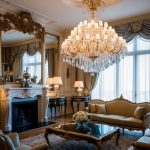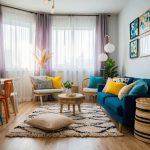The Ultimate Guide to Choosing the Perfect Paint Colors for Every Room in Your Home: Expert Tips and Tricks
Choosing the perfect paint colors for every room in your home can be a daunting task, but it significantly impacts the ambiance and feel of your space. The right colors can transform a room, creating the perfect mood whether you’re aiming for relaxation, energy, or creativity. This guide will help you navigate through the process with ease, providing you with practical tips and expert advice.
Understanding color psychology is key to making informed decisions. Each color elicits a specific reaction; for example, blues and greens are calming, while reds and oranges are invigorating. By aligning your color choices with the intended function of each room, you can create a cohesive and harmonious home environment.
Lighting plays a crucial role in how paint colors appear on your walls. Natural and artificial light can alter the perception of color throughout the day. Testing paint samples in different lighting conditions ensures that you choose a shade that consistently looks great in your space. With these considerations in mind, you can confidently select the perfect paint colors for every room.
Understanding Color Psychology
Color psychology explores how different hues can affect human emotions and behaviors. It plays a critical role in interior design, influencing mood, perception, and overall atmosphere of a space.
Emotional Impact of Colors
Colors have distinct emotional triggers. Blue often induces a sense of calm and tranquility, making it suitable for bedrooms and bathrooms. Red is associated with energy and passion, which can be invigorating but overwhelming in large doses. Yellow tends to evoke happiness and warmth, enhancing feelings of optimism in kitchens or living rooms. Green embodies nature, promoting relaxation and balance, ideal for home offices or living spaces. Purple, linked to luxury and creativity, can add sophistication to a room. Each color has the ability to create a unique emotional environment.
Color Psychology in Interior Design
Applying color psychology to interior design involves strategic color choices to achieve desired atmospheres. For example, using soothing blues and greens in a bedroom can promote restful sleep, while vibrant hues like red and orange in a dining room can stimulate appetite and conversation. Neutral tones such as beige and gray offer a versatile backdrop, allowing other design elements to stand out. Complementary color schemes enhance visual appeal and balance. Designers also consider lighting and accent colors to further fine-tune the desired ambiance. The careful selection of colors can transform a space, making it both functional and aesthetically pleasing.
Analyzing Natural Light in Your Rooms
Natural light can dramatically impact the appearance of paint colors in your home. Analyzing how light changes throughout the day and selecting colors that suit various lighting conditions can help create the perfect atmosphere for each room.
Mapping Out Light Throughout the Day
Understanding how light moves through your home is crucial. South-facing rooms typically receive abundant direct sunlight, making colors appear warmer and more vibrant. North-facing rooms receive cooler, indirect light, which can make colors look more subdued and even somewhat gray.
East-facing rooms get bright, warm light in the morning, casting a golden glow that’s flattering for soft, warm colors. In the afternoon, these rooms transition to cooler tones. West-facing rooms, on the other hand, experience dim, cool light in the morning but are flooded with warm, intense light in the afternoon and early evening. This change can make colors appear richer and more saturated as the day progresses.
Keeping these variations in mind can help you choose colors that maintain the desired mood throughout the day.
Choosing Colors for Varying Light Conditions
Once you’ve mapped out the light patterns, the next step is selecting colors that complement these conditions. In south-facing rooms, consider cooler hues like blues or grays to balance the intense warmth of the natural light. For north-facing rooms, warmer colors such as creams, yellows, and warm neutrals can compensate for the lack of bright, direct sunlight.
In east-facing rooms, you might opt for bright, warm colors that take advantage of the morning light. Soft pastels and light warm tones often look best here. Conversely, west-facing rooms benefit from stronger colors that can handle the intense afternoon sun. Earthy tones, rich reds, and deep blues work well in this light.
Always test paint samples on your walls and observe them at different times of the day to ensure the colors look good in all lighting conditions.



